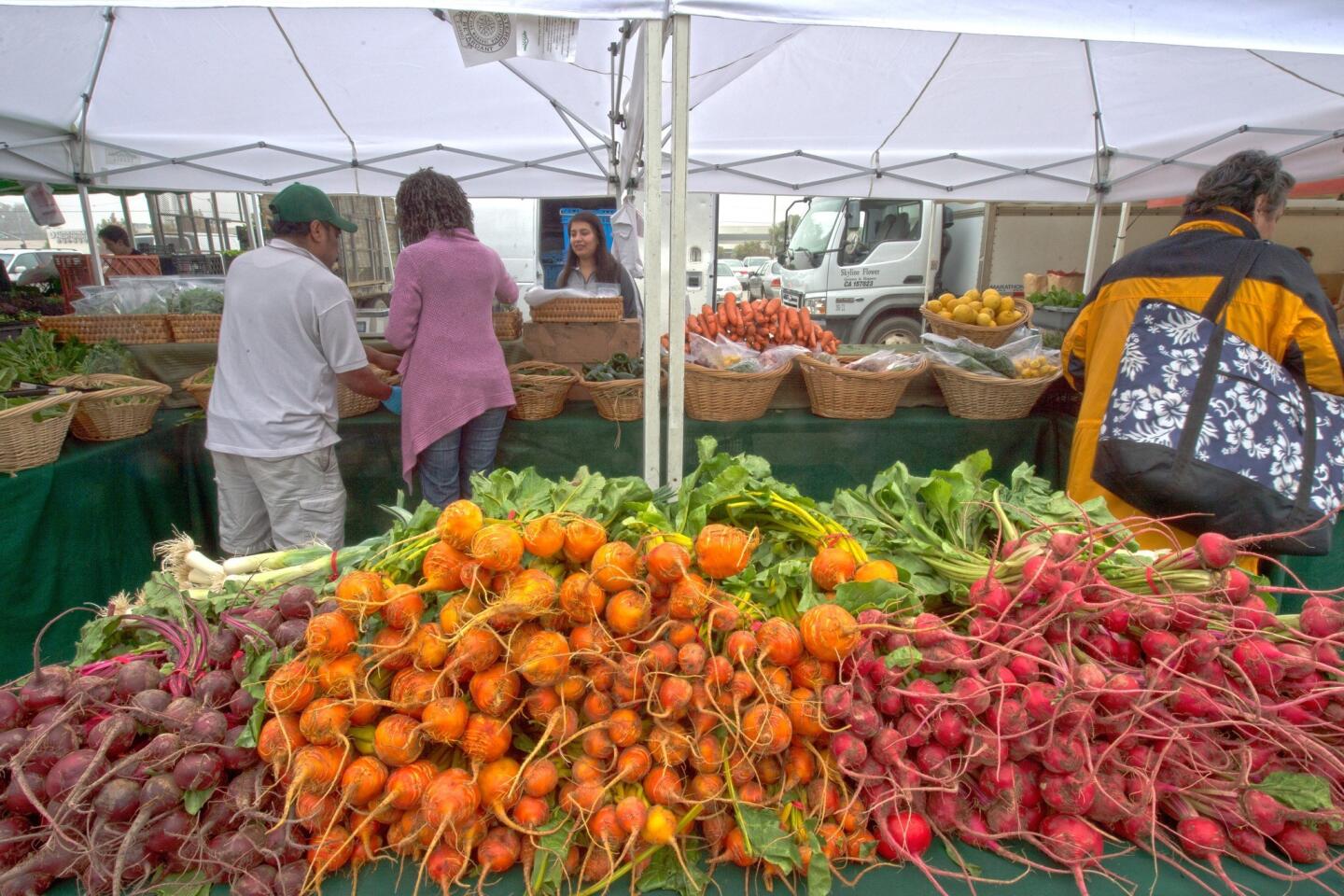Farmers Markets: Seasons do matter in Southern California
- Share via
The great advantage of Southern California farmers markets — year-round availability of fresh, local produce — can sometimes backfire by obscuring the seasonal rhythm of crops and growing areas. For example, carrots, grapefruits, nuts and avocados are always available from somewhere but not always at their best; it’s up to shoppers to learn the difference.
Grown from the Mexico to the Oregon borders, carrots often look good but are starchy and vegetal in summer; the tenderest, crispest, sweetest ones come in winter, when the roots naturally accumulate nutrients. Particularly fine are the Nantes Slendero carrots grown in Santa Ynez by Shu Takikawa, who saved the seed after the variety was orphaned by the seed company; Seeds of Diversity actually lists the variety as “apparently extinct.” Shu and his wife, Debby, call their farm the Garden of ..... and have been selling at the Mar Vista market. They started going to Hollywood also several weeks ago.
Because grapefruit is of tropical origin, it needs heat over many months to develop sweetness and juiciness. That’s why the Coachella desert, where the harvest runs from December to April, is California’s top grapefruit district. Most desert citrus growers are too big to bother with farmers markets, but Everett Davall, scion of a family that has farmed in the Coachella for almost a century, has just started bringing new-crop Ruby grapefruit to Pasadena Saturday, Irvine, Hollywood, Studio City and Santa Monica Wednesday. Robert Lower of Flying Disc Ranch also sells excellent desert grapefruit from Thermal at Santa Monica on Wednesdays.
From less torrid districts, old-crop grapefruit (from the spring 2011 flowering) can be sweet but is likely to be granulated, dry at the bottom end, by now. New-crop California grapefruit from anywhere but the desert is currently sour enough to be nearly poison.
Oroblancos and Melogolds, which are low-acid pummelo-grapefruit hybrids, are at their peak from the San Joaquin Valley. These varieties grown in Southern California may be decent now, but they’ll be much better in a month.
Most growers store their nuts properly so that they can keep for a year or more in good condition, but some don’t, and poorly stored nuts can be rancid. Most California-grown nuts are harvested in autumn, and so at this time of year shoppers should look for the new crop. However, most nuts require processing, such as mechanical shelling, which can be done several months or more after harvest, so it’s not always clear when farmers market vendors start to bring their new crop. At farmers markets, as long as the vendor knows what he or she is selling, it’s possible to find out.
Among nut growers who have just started to bring their new crop, Rancho La Viña of Lompoc has creamy Payne walnuts at the Hollywood and Santa Monica (Saturday downtown and Wednesday) markets. The new crop from Santa Barbara Pistachios (actually grown in Cuyama) has just arrived at these markets, along with Mar Vista and Ojai. David Eakin of Riverside has just-harvested Wichita and Select pecans at Santa Monica Wednesday. This Sunday, George Yemetz will start bringing new-crop Carmel almonds grown in Livingston to the Hollywood market.
December is a challenge for avocado lovers. Most old-crop Hass are over-mature by now, and commercial growers have long since unloaded their stores, but some farmers market vendors try to stretch out their sales through autumn. New-crop Hass, on the other hand, are watery. The California Avocado Commission sets the legal maturity release dates for new-crop avocados, organized by variety and size, since the larger fruit mature earlier.
The upshot for consumers is that unless old-crop Hass (or even late-maturing Reeds) come from cooler coastal districts, such as Morro Bay or possibly Santa Barbara, avoid them. Look for the new crop of thin-skin varieties, which are rarely shipped commercially because they’re perishable. The best bets now are large fruits of the early-maturing Bacon and Fuerte varieties.
Another good choice would be Mexican-race avocados such as Stewart (from Laura Ramirez and Beylik), Mexicola and Topa Topa, which have thin, edible skins with a distinctive anise flavor. It’s the tail end of the season for these, but this is when they’re highest in oil content.
More to Read
Eat your way across L.A.
Get our weekly Tasting Notes newsletter for reviews, news and more.
You may occasionally receive promotional content from the Los Angeles Times.











